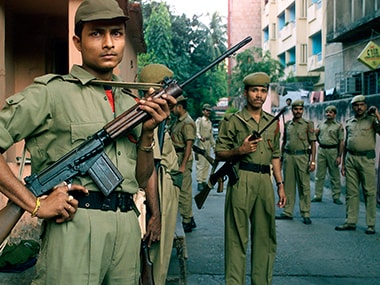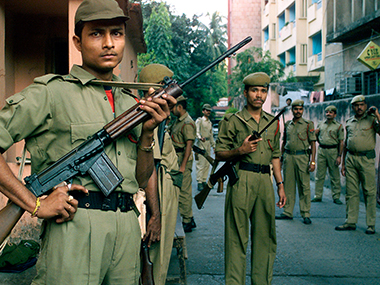Reports of likely withdrawal of the Armed Forces (Special Powers) Act, 1958 from Assam sometime after the publication of the final list of updated National Register of Citizens on 31 July has brought the issue of the capability of the Assam Police to carry out counter-insurgency operations independently to the centre stage. Withdrawal of the AFSPA will surely create a new perception of the prevailing security situation in Assam as the army would then be relieved from counter-insurgency operations in the state after 29 consecutive years. However, it would not necessarily mean Assam Police has become self-sufficient to meet the challenge on its own. [caption id=“attachment_4131971” align=“alignleft” width=“380”]  Assam Police personnel. Reuters[/caption] The ground realities indicate that even after the withdrawal of the AFSPA, the Assam government will remain dependent on Central paramilitary forces to meet the operational requirement of counter-insurgency in the state. For, Assam still lacks a specialised counter-insurgency force like Tripura State Rifles (TSR) on the pattern of Central Paramilitary Force to meet the challenge of counter-insurgency operations without the support of Central forces. Besides, the state has remained far from achieving the primary objective of the Modernisation of State Police Force Scheme of reducing dependency on the army and Central Armed Forces. A grenade blast claimed to have been triggered by the Paresh Barua-led United Liberation Front of Asom (Independent) in Guwahati on 12 May that left 12 injured indicate that even though insurgency has declined, the possibility of militants regrouping and adopting more desperate tactic will keep the security top brass on toes for some more time. The AFSPA was imposed in Assam in 1990 following a spurt in insurgent activities of the United Liberation Front of Asom (ULFA). The army role in counter-insurgency operations in Assam was made more structural in nature in 1997 when the state was brought under three-tiered Unified Command Structure of the army, Assam Police and Central paramilitary forces and the Army was entrusted with the duty of heading the operational command. Even though the state government has extended the AFSPA in the state, deployment of army for counter-insurgency operation has reduced gradually with the reduction in insurgent activities due to synergised counter-insurgency operations under the Unified Command Structure and the crackdown by Bhutan, Bangladesh and Myanmar on insurgents from Assam. However, the Central Paramilitary Organisation (CPO)s have replaced the army in an operational role in some of the districts. Official data show that in the last four years since 2014, there has been 63 percent reduction in insurgency incidents in the northeastern region. According to the Ministry of Home Affairs, the year 2018 witnessed the lowest number of insurgency incidents and civilian deaths in the region since 1997. Assam Police has one elite commando force to combat insurgency – Assam Police Commando Battalion which was raised on 18 January, 1996. Known as Black Panthers, the commandos received training in Punjab in 1995. Nearly 12 years later it raised the Special Task Force in 2008 with jurisdiction all over the state to perform “exceptionally dangerous, high risk, counter terrorism operations that fall outside of the abilities of the District Police”. Headed by an officer in the rank of Inspector General of Police, the mandate of the STF is also to conduct investigation of extremist/ terrorist-related cases of complicated nature and far-reaching consequences which also includes investigation of specially organised crimes.
In Tripura, the TSR was raised in 1984 on the pattern of CPMF under the Tripura Rifles Act, 1983 passed by Tripura Legislative Assembly. TSR currently has 12 battalions under it which played the critical role in containing insurgency in the state. Tripura government withdrew AFSPA in 2015 after 18 years of its imposition. The AFSPA was imposed in Tripura in 1997.
An impact assessment study of the erstwhile Modernisation of the State Police Force Scheme conducted by Ernst & Young pertaining to the period from 2000-01- to 2008-09 points towards how the scheme failed to bridge the gap of mobility and infrastructure for Assam Police and explains its dependence on the army and the Central paramilitary forces over the past nearly 29 years of imposition of the AFSPA. The report of the impact assessment study available on the Ministry of Home Affairs website reveals that the availability of vehicles per 100 policemen has decreased to 5.81 in 2008 from 11.81 in 1998. Similarly, the availability of staff quarters has declined from 29.65 per 100 policemen in 1998 to 13.64 in 2008 and the availability of police station decreased from 0.83 per 100 policemen to 0.42. Such decline was attributed to increasing in strength from 22,895 in 1998 to 61,975 personnel in 2008. The current sanctioned strength of Assam Police is about 65,000 but over 9,500 posts of different ranks are lying vacant for the past several years. “The objective of the scheme is to gradually reduce the dependence of the State Governments on the Army and the Central Armed Police Forces to control internal security and law and order situations by equipping the State Police Forces adequately and strengthening their training infrastructure. The focus of the scheme is to strengthen police infrastructure at cutting edge level by construction of secure police stations, training centres, police housing (residential), equipping the police stations with the required mobility, modern weaponry, communication equipment and forensic set-up etc,” states the objectives of the erstwhile Modernisation of State Police Force Scheme of the Ministry of Home Affairs. Under the scheme, Assam falls in category A states comprising other states in North East and Jammu and Kashmir which are eligible to receive financial assistance on 90:10 Centre:State sharing basis. Remaining states are eligible for financial assistance on 60:40 Centre:State sharing basis.
The annual Central allocation for the scheme for the entire country stood reduced to Rs 595 crore in 2015-16 and in 2016-17 against Rs 1,341 crore in 2013-14 and Rs 1,397 crore in 2014-15. In 2017-18 the allocation was Rs 769 crore.
Besides, Assam received Rs 1,072.40 crore under reimbursement of Security Related Expenditure Scheme for various security-related expenditure including logistics provided to army, Central Armed Police Forces, raising of India Reserve Battalions, ex-gratia grant and gratuitous relief to the victims of extremist violence, honorarium paid to Village guards/Village Defence Committees, Home Guards deployed on security duty, 75 percent of expenditure in fuel and lubricants used in operations, ex-gratia of next of kin of police personnel killed in insurgent attack and expenditure incurred on maintenance of designated camps set up for insurgent groups with which the government has entered into Suspension of Operation agreement. After a review of the SRE scheme for the North East, the amount earmarked under different heads has been revised with effect from 1 April, 2018. The maintenance expenses of designated camps for each cadre has been increased to Rs 6,000 from Rs 3,000, ex-gratia to next of kin of police personnel killed in insurgent violence has increased to Rs 20 lakh from Rs 3 lakh, and to next of kin of civilian killed to Rs 2 lakh from Rs 1 lakh and for permanent disability of police personnel the amount has been increased Rs 5 lakh from Rs 75,000. Clearly, even after withdrawal of the AFSPA, the state will have to continue seeking the reimbursement of expenditure on logistics for deployment of Central Armed Police Forces till all the outfits currently active including the ULFA (I) joins the peace process and for footing the bill for maintenance of cadres of the outfits engaged in peace talks till accords are signed with them. The author is Editor, nezine.com.


)

)
)
)
)
)
)
)
)



